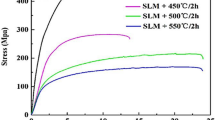Abstract
The present study discusses the finite element modeling and simulation strategy of projectile impact on thin ductile target like aluminum. Ogive nose projectile was chosen to impact on aluminum target normally by velocities at and above the ballistic limit of the plate. Abaqus/Explicit finite element code was used to model the problem. To define the thermo-viscoplastic behavior of the metal target, Johnson-Cook flow stress was used in conjunction with damage initiation criterion to predict the complete perforation process. Further, Hillerborg’s damage evolution proposal, based on stress-displacement response, was followed to observe the damage response after the failure has initiated in the material. Various parameters, like choice of element size, hourglassing, aspect ratio of elements, etc. which plays an important role in the simulation, have been studied. The result obtained with the presented model is compared with the results from the literature, and good agreement between them was found.
Access this chapter
Tax calculation will be finalised at checkout
Purchases are for personal use only
Similar content being viewed by others
References
Backman ME, Goldsmith W (1978) The mechanics of penetration of projectiles into targets. Int J Eng Sci 16:1–99
Corbett GG, Reid SR, Johnson W (1996) Impact loading of plates and shells by free-flying projectiles: a review. Int J Impact Eng 18:141–230
Goldsmith W (1999) Non-ideal projectile impact on targets. Int J Impact Eng 22:95–395
Gupta NK, Ansari R, Gupta SK (2001) Normal impact of ogival nosed projectiles on thin plates. Int J Imp Eng 25:641–660
Gupta NK, Madhu V (1997) An experimental study of normal and oblique impact of hard-core projectile on single and layered plates. Int J Imp Eng 19:395–414
Prakash T, Sekhon GS, Gupta NK (2003) Adaptive finite element analysis of plastic deformation of plates under projectile impact. J Defence Sci 53(1):57–65
Borvik T, Langseth M, Hopperstad OS, Malo KA (2002) Perforation of 12 mm thick steel plates by 20 mm diameter projectiles with flat, hemispherical and conical noses: part I: experimental study. Int J Imp Eng 27:19–35
Ansari R, Khan SH, Khan AH (2010) Oblique impact of cylindro-conical projectile on thin aluminium plates CD. In: Proceedings ICTACEM 2010, Dec 27–29. IIT Kharagpur, India, pp 361–363
Borvik T, Langseth M, Hopperstad OS, Malo KA (2002) Perforation of 12 mm thick steel plates by 20 mm diameter projectiles with flat, hemispherical and conical noses: part II: numerical study. Int J Imp Eng 27:37–64
Gupta NK, Iqbal MA, Sekhon GS (2007) Effect of projectile nose shape, impact velocity and target thickness on deformation behavior of aluminium plates. Int J Solids Struct 44:3411–3439
Deb A, Raguraman M, Gupta NK, Madhu V (2008) Numerical simulation of projectile impact on mild steel armour plates using LS-DYNA, part I: validation. Defence Sci J 58:422–438
Husain Afsar, Ansari Raisuddin, Khan Arshad Hussain (2017) Experimental and numerical investigation of perforation of thin polycarbonate plate by projectiles of different nose shape. Latin Am J Solids Struct 14(2):357–372
Husain A, Hussain Khan A, Ansari R (2018) Ballistic performance evaluation of polycarbonate plate based on quasi-static perforation. IOP Conf Ser Mater Sci Eng 377:012087
Khan AA, Naushad Alam M, Rahman N, Wajid M (2016) Finite element modelling for static and free vibration response of functionally graded beam. Latin Am J Solids Struct 13(4):690–714
Iqbal MA, Chakrabarti A, Beniwalm S, Gupta NK (2010) 3D numerical simulations of sharp-nosed projectile impact on ductile targets. Int J Impact Eng 37:185–195
Ansari R (1998) Normal and oblique impact of projectiles on single and layered plates. PhD thesis, IIT Delhi
Johnson GR, Cook WH (1983) A constitutive model and data for metals subjected to large strains, high strain rates and high temperatures. In: Proceedings of the seventh international symposium on Ballistics. The Hague
Johnson GR, Cook WH (1985) Fracture characteristics of three metals subjected to various strain, strain rates. Temp Press Eng Fract Mech 21:31–48
Iqbal MA, Gupta G, Gupta NK (2010) 3D numerical simulations of ductile targets subjected to oblique impact by sharp nosed projectiles. Int J Solids Struct 47:224–237
Zukas JA, Scheffler DR (2000) Practical aspects of numerical simulations of dynamic events: effects of meshing. Int J Impact Eng 9:925–945
Version 6.11 ABAQUS analysis user’s manual (2011) vol 2
Gupta NK, Madhu V (1992) Normal and oblique impact of a kinetic energy projectile on mild steel plates. Int J Impact Eng 12:333–343
Hillerborg A, Modeer M, Petersson PE (1976) Analysis of crack formation and crack growth in concrete by means of fracture mechanics and finite elements. Cem Conc Res 6:773–782
Khan WU, Ansari R, Gupta NK (2003) Oblique impact of projectile on thin aluminium plates. Defence Sci J 53:139–146
Author information
Authors and Affiliations
Corresponding author
Editor information
Editors and Affiliations
Rights and permissions
Copyright information
© 2020 Springer Nature Singapore Pte Ltd.
About this paper
Cite this paper
Khan, S.H., Agnihotri, S.K., Khan, A.A., Husain, A. (2020). Finite Element Modeling and Simulation of Projectile Impact on Ductile Target. In: Kumar, H., Jain, P. (eds) Recent Advances in Mechanical Engineering. Lecture Notes in Mechanical Engineering. Springer, Singapore. https://doi.org/10.1007/978-981-15-1071-7_36
Download citation
DOI: https://doi.org/10.1007/978-981-15-1071-7_36
Published:
Publisher Name: Springer, Singapore
Print ISBN: 978-981-15-1070-0
Online ISBN: 978-981-15-1071-7
eBook Packages: EngineeringEngineering (R0)




